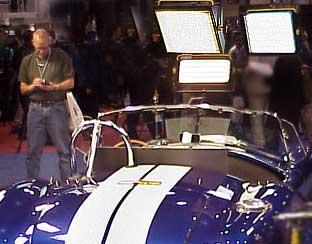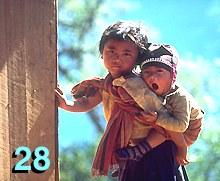|
Sunlight's Varying Color Temperature
The color of sunlight can actually
vary greatly, depending on the time of day, the amount of haze or smog in the air,
and the geographic longitude and latitude of the area. 
Because of its angle to the earth in the early morning and late
afternoon, sunlight must travel through more of the earth's atmosphere.
Note the different lengths of the red lines on the left. The
longer line in the drawing represents the sun's angle at sunrise or sunset.
The longer path results in more blue
light being absorbed than red. (Shorter wavelengths of light are more readily absorbed.)
Consequently, the color temperature of the sun is shifted toward red, which  accounts
for the red in sunrises and sunsets. (Note photo here.) accounts
for the red in sunrises and sunsets. (Note photo here.)
During midday, the sun's rays have less distance to travel through
the atmosphere (the overhead sun in the illustration) and the temperature of direct
sunlight at noon equals about 5,500K. (Depending on conditions, this number can
be from 5,400 to 6,000K.)
As the sun moves across the sky there are subtle color shifts.
And, if the sun moves in and out of cloud cover, color temperatures (and light quality)
will also dramatically change.
Color temperature is also shifted
as a result of traveling through haze or an overcast sky. If a camera is not color-balanced
under these conditions, this light will impart a cold, bluish look to skin tones.
The color temperature of average summer shade is rather blue-about
8,000K. Midday skylight (no direct sun) can range from 9,500K to 30,000K.
Why is the color temperature of shade or the light from the sky
higher than direct sunlight? In both cases it's
not
the direct sunlight that predominates, but light
from the blue sky.
Artificial Light Sources
 We
mentioned that 3,200K is the standard color temperature for TV lighting-considerably
lower (redder) than average daylight. Note the high proportion of yellow and red
in the incandescent area of this illustration. We
mentioned that 3,200K is the standard color temperature for TV lighting-considerably
lower (redder) than average daylight. Note the high proportion of yellow and red
in the incandescent area of this illustration.
This artificial type of lighting is commonly referred to as
incandescent light, or tungsten light,
after the coiled tungsten filament in these lamps.
To see the difference between this and daylight, refer back
to the photo of the woman at the beginning of this section.
Not all incandescent light is 3,200K.
A common 100-watt light bulb, for example, is only about 2,850K. A candle flame
(for those of you who have a need to shoot productions under candlelight!) is even
redder-about 1,900K.
Most of the differences in these sources can be handled
by the white balance circuitry of your video camera-assuming you remember to regularly
white balance your camera. There are, however, sources of artificial illumination
that tend to defy proper color (white) balancing.
Broken Spectrum Sources
You may have noticed that sometimes
videos and still photos shot under standard fluorescent lights often exhibit a greenish-blue
cast. Fluorescent lamps belong to the group of lighting devices known collectively
as discharge lamps-glass tubes filled with metal vapor with
electrodes at each end.
Unlike tungsten-type lights, standard fluorescent lamps have
a broken spectrum. Instead of a relatively smooth mix of colors from infrared
to ultraviolet, fluorescent light has sharp bands or spikes of color-primarily in
the blue-green areas. Even though the eye will not notice these spikes, color shifts
can result with video.
Although a blue-green cast used to be rather obvious in
video shot under fluorescent lights, recent improvements in CCD/CMOS
color response have reduced the problem.
The Daylight Fluorescent Tube
Using a popular fluorescent tube,
the daylight fluorescent, as an  example,
the average color temperature for this tube is 6,500K. Note in this illustration
the jumps in the blue-green areas of the color spectrum. This means that blue-green
tones can be exaggerated and reds will be rendered slightly gray and dull. example,
the average color temperature for this tube is 6,500K. Note in this illustration
the jumps in the blue-green areas of the color spectrum. This means that blue-green
tones can be exaggerated and reds will be rendered slightly gray and dull.
Although some video cameras have fluorescent filters included
in their filter wheels, they can't completely or consistently solve these problems.
For one thing, there are about 30 different fluorescent tubes in use, each with
slightly different color characteristics. In terms of color temperature they range
from 6,500K to less than 3,000K.
Warm-White Fluorescent
The standard consumer-type fluorescent
lamp that causes the least color temperature problem is the warm-white fluorescent,
at 3,050K. Even though this type of fluorescent light can make subject matter look
slightly pale and greenish, it will produce satisfactory results-assuming the camera
is color balanced on a white card, and assuming perfect color fidelity isn't a goal.
To avoid the unpredictable effects of standard fluorescent
lights, videographers who want to accurately reproduce skin tones simply
turn the fluorescents
off and set up their own lighting equipment. This not only solves the
color temperature problem, but it brings the light up to an more acceptable
level.
Color-Balanced Fluorescent Lamps
Thus far in this discussion we have
used the term "standard fluorescent lights." In recent years, at least two fluorescent
tube manufacturers have started producing high-intensity fluorescent bulbs that
use special chemical compounds to smooth out the spectrum spikes found in standard
fluorescent tubes. 
Banks of color-balanced fluorescent lights
produce a soft, virtually shadowless light over a wide area. This type of light
(shown on the right) has been gaining popularity in certain studio applications.
Compared to traditional studio lighting, it generates much less heat and consumes
much less energy.
However, since these fluorescent banks can't project light any
great distance, their use is limited to subject matter that's relatively close to
the lights. Often, color-balanced fluorescent banks are used to provide an over-all,
even lighting, and other, more coherent lighting instruments are then added as accent
(key) lights.
Other Types of Discharge Lights
Other types of discharge lamps can
cause  much
more severe color problems. much
more severe color problems.
One type, the sodium vapor lamp, used primarily for street
lighting, produces a brilliant yellowish-orange, broken spectrum light that will
drastically (and hopelessly) skew color balance. (Note photo on the left.)
Operating at higher internal pressures
are mercury vapor lamps, sometimes used for large interior areas such as gymnasiums.
Although the basic color temperature ranges from 3,500K to 5,900K, depending on
the lamp, because these lamps have a badly fractured spectrum, they can do strange
things to color. Sometimes they are mixed with other types of lamps to smooth out
the color spectrum problem.
Another type of broken spectrum discharge lamp is the metal
halide lamp with a basic color temperature that ranges from 3,800K to 5,900K.
Although many of the color
temperature problems we've discussed may not be obvious to the eye, thanks to approximate
color consistency, they can present major problems when you attempt to match successive
scenes during editing. This represents just one type of technical
continuity problem (scene-to-scene technical inconsistency) that you can
encounter in video production.
TV Set and Video Monitor Color Balance
Before leaving the subject of color
temperature we need to mention a factor that also needs to be considered in reproducing
video and film images-the inherent color temperature of the TV sets and color monitors
that display the pictures.
Professional TV monitors use a standardized set of SMPTE color
phosphors that create "white" at 6,500K. Note that this is bluer than sunlight,
and much bluer than incandescent light.
However, the color temperature of most home TV sets is considerably
higher than 6,500K-commonly 7,100K in the United States and 9,300K in Japan. TV
sets sold in most European countries are much closer to the 6,500K standard.
One of the reasons for the high color temperature in U.S. and
Japanese sets is the consumer desire for bright, saturated colors, which are easier
to create when there is a large blue component in the phosphor mix.
It's too early to tell about color
standards with the new LCD, DLP and plasma flat-screen TV displays. Right now they
vary significantly. This is in part due to the fact that this technology is
still in a rather early stage of development.

|

 For
example, in the photo on the right, both sources of light (sunlight on the right;
a standard light bulb on the left) normally appear as white light to the eye. It's
only when we see them together as we do here that the difference in color temperature
becomes obvious.
For
example, in the photo on the right, both sources of light (sunlight on the right;
a standard light bulb on the left) normally appear as white light to the eye. It's
only when we see them together as we do here that the difference in color temperature
becomes obvious. 
 accounts
for the red in sunrises and sunsets. (Note photo here.)
accounts
for the red in sunrises and sunsets. (Note photo here.) We
mentioned that 3,200K is the standard color temperature for TV lighting-considerably
lower (redder) than average daylight. Note the high proportion of yellow and red
in the incandescent area of this illustration.
We
mentioned that 3,200K is the standard color temperature for TV lighting-considerably
lower (redder) than average daylight. Note the high proportion of yellow and red
in the incandescent area of this illustration. example,
the average color temperature for this tube is 6,500K. Note in this illustration
the jumps in the blue-green areas of the color spectrum. This means that blue-green
tones can be exaggerated and reds will be rendered slightly gray and dull.
example,
the average color temperature for this tube is 6,500K. Note in this illustration
the jumps in the blue-green areas of the color spectrum. This means that blue-green
tones can be exaggerated and reds will be rendered slightly gray and dull. 
 much
more severe color problems.
much
more severe color problems.